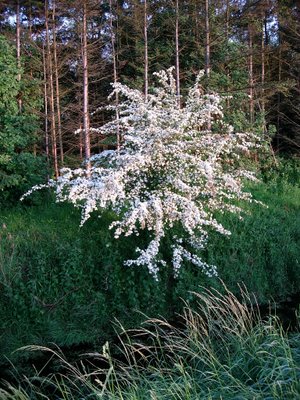Sunday, May 21, 2006
May Blossom

I took this when I had a walk around the fen tonight. The picture doesn't really do it justice, but the hawthorn blossom looked resplendent in the evening sun.
Comments:
<< Home
How beautiful! "Took a walk around the fen tonight." It's like saying you took a walk in your backyard. Is that correct? Have you ever read "The Plague Dogs" by Richard Adams? I had thought to include the very last paragraph in my blog (once it gets up and running, that is). I looked up Coniston Fen and it's on your West Coast, and it would be interesting if his description matches yours of 'your fens.' The blossoms arrive about the same time as our red bud, and dogwoods. There are some things which inspire awe, and less words. So I'll zip it. Thank you for taking the photo.
This tree reminds me of the Dogwood tree I saw for the first time last week in Ohio. They are native to the East Coast of the U.S. Now I can say that I've seen a Dogwood and have "seen" a Hawthorne of the Fen.
I've checked and it not related to dogwood (Did you get a picture of that Dogwood, Annie?). It's proper name is 'Crataegus monogyna' and it makes a good animal-proof thorny hedge. The young leaves are edible and supposed to be good for the circulation. It's very common over here but not native to the US. It also makes very good firewood, though chopping down a hawthorn bush without a very good reason used to be considered very bad luck.
I will try to find a copy of Plague Dogs, though I've not read it.
I don't know about Coniston Fen. There is a Coniston Fell in the lake district (as painted by Turner). That's a very beautiful area. People like Wordsworth, John Ruskin and Beatrix Potter lived around there.
The fen to which I referred is an area of drained, flat, fertile farmland. It's not in my backyard, but our house is on an area known as Hasse Fen. Other local fens are Great Fen, Qua Fen, Burnt Fen, etc. There is even one called Grunty Fen. These are old names and there are no real divisions between them. They are all areas of a large drained area called 'The Fens' which covers much of East Anglia. Before Dutch engineers came over with their drainage knowledge the whole area was a swampy, hostile environment (for people, though it was great for wildlife). Wicken Fen, however, is a nearby nature reserve where they pump the water in rather than out to restore the old environment. Mind you, as we live at sea level, even though we are about 60 miles from the coast, the rising tides might just restore it all whether we like it or not.
I will try to find a copy of Plague Dogs, though I've not read it.
I don't know about Coniston Fen. There is a Coniston Fell in the lake district (as painted by Turner). That's a very beautiful area. People like Wordsworth, John Ruskin and Beatrix Potter lived around there.
The fen to which I referred is an area of drained, flat, fertile farmland. It's not in my backyard, but our house is on an area known as Hasse Fen. Other local fens are Great Fen, Qua Fen, Burnt Fen, etc. There is even one called Grunty Fen. These are old names and there are no real divisions between them. They are all areas of a large drained area called 'The Fens' which covers much of East Anglia. Before Dutch engineers came over with their drainage knowledge the whole area was a swampy, hostile environment (for people, though it was great for wildlife). Wicken Fen, however, is a nearby nature reserve where they pump the water in rather than out to restore the old environment. Mind you, as we live at sea level, even though we are about 60 miles from the coast, the rising tides might just restore it all whether we like it or not.
You are correct, it is Coniston Fell. Rechecked. English is soooo great! Looked up both fell and fen. Wow. As for the dogwoods: Columbia College in Sonora has many dogwoods on campus, and what with the surrounding forest and the dogwoods and redbud, this is a campus to die for. I was sad to leave in '01, and it took me a while to feel at home in Turlock. Home is where the heart is.
Hi Jeremy: thanks for visiting my blog - thought I'd return the favour. We have a red hawthorn in our garden - not as spectacular as your white - but pretty interesting all the same. I love the way you have to get really close to properly appreciate the flowers - arranged like perfect miniature nosegays along the branch.
Post a Comment
<< Home


